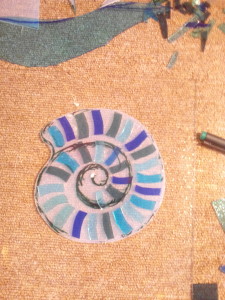Having tried out a few different techniques for glass fusing with ferns, and finalising the best, I have now moved on to the main reason for all this, the insert for the oak tray I am currently carving.
 I started with 3 ferns coated with green glass powder.
I started with 3 ferns coated with green glass powder.
These were fused to a sheet of clear glass.
With the carbon residue from the ferns themselves removed, this left the glass powder behind, reflecting the fern shape and form.
Next the sheet was turned upside down and a sheet of opaque white glass put on top, as the background.
This meant that what was to become the top surface was against the kiln plate. The reason I did it this was around was to give the top surface a textured finish to match the fern feel. The glossy, shiny top surface of the glass in then on the bottom and hidden.
The result is below:

 I have tried to show the silk surface texture in this picture.
I have tried to show the silk surface texture in this picture.
All I need to do now is complete the oak tray which this will be inserted into.














